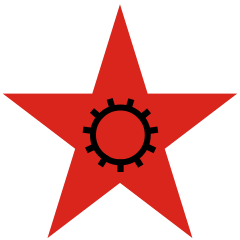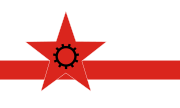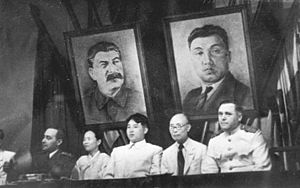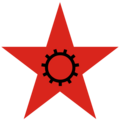Workers' Party of North Korea facts for kids
Quick facts for kids
Workers' Party of North Korea
북조선로동당
|
|
|---|---|
 |
|
| Chairman | Kim Tu-bong |
| Vice Chairmen | Kim Il Sung Chu Yong-ha Ho Ka-i |
| Founded | 28 August 1946 |
| Dissolved | 24 June 1949 |
| Merger of | Communist Party of Korea New People's Party of Korea |
| Merged into | Workers' Party of Korea |
| Headquarters | Pyongyang |
| Newspaper | Rodong Sinmun Kunroja |
| Youth wing | Democratic Youth League of North Korea |
| Pioneer wing | North Korean Children's Union |
| Labour wing | General Federation of Trade Unions of North Korea |
| Membership (1946) | 366,000 |
| Ideology | |
| Political position | Far-left |
| National affiliation | Fatherland United Democratic Front |
| Colors | Red |
| Supreme People's Assembly |
172 / 572
|
| Party flag | |
 |
|
| Workers' Party of North Korea | |
| Chosŏn'gŭl | |
|---|---|
| Hancha | |
| Revised Romanization | Bukjoseon Rodongdang |
| McCune–Reischauer | Pukchosŏn Rodongdang |
The Workers' Party of North Korea (Korean: 북조선로동당; Hancha: 北朝鮮勞動黨) was an important communist party in North Korea. It existed from 1946 to 1949. This party was a key step in forming the current Workers' Party of Korea.
It was created at a meeting held from August 28 to 30, 1946. Two groups joined together to form it: the northern part of the Communist Party of Korea and the New People's Party of Korea. Kim Tu-bong, who led the New People's Party, became the chairman. Chu Yong-ha and Kim Il Sung were chosen as vice chairmen. When the party started, it had about 366,000 members. These members were organized into about 12,000 small groups called party cells.
Contents
How the Party Was Formed
The joining of the North Korea Bureau of the Communist Party of Korea and the New People's Party was similar to other mergers happening in Eastern Europe. This was after Second World War. Examples include the creation of the Socialist Unity Party of Germany.
The two parties joining was not easy. They had differences in who their members were and what they believed. The New People's Party had many educated people. The Communist Party was mostly made up of workers and farmers. Also, the Korean communists had different groups within them. These groups were all part of the new party.
At the first meeting of the new party, they discussed their main ideas. Kim Il Sung said that the Workers' Party was like a "combat unit" for working people. He stressed that the party needed to be pure and united. This meant keeping its strong beliefs, like Marxism–Leninism.
Different Groups Inside the Party
The party had four main internal groups, often called factions. These groups were: the Soviet Koreans, the Domestic faction, the Yan'an (or Chinese) faction, and the Guerrilla faction. These divisions came from the older Communist Party of Korea. One of them, the 'Domestic' faction, was also found in the Workers Party of South Korea.
- The Soviet Koreans were led by Ho Ka-i. They were ethnic Koreans born or raised in Russia. Their families had moved there starting in the 1870s. Some returned to Korea secretly as communists in the 1920s and 1930s. Most were members of the Red Army or civilians who came to North Korea after World War II. Many worked as translators or Russian teachers. This group helped build the Communist Party in Pyongyang right after the war.
- The Domestic faction were Korean communists who stayed in Korea. They fought against the Japanese occupation. Many spent time in Japanese prisons because of their actions. Important members included O Ki-sop and Chu Yong-ha. This group was connected to the old Communist Party of Korea leaders in Seoul.
- The Yan'an faction was led first by Mu Chong, then by Kim Tu-bong and Choe Chang-ik. These were Korean exiles who lived in China's Shaanxi province. They joined the Chinese Communist Party. They formed their own group, the North-Chinese League for the Independence of Korea. When they returned to North Korea, they formed the New People's Party. This party later joined with the Communist Party in 1946. Many in this group fought with Mao Zedong's armies in China.
- The Guerrilla faction was led by Kim Il Sung. This group was made up of former Korean fighters. They had been active in Manchuria after Japan took it over in 1931. Many had to leave Manchuria and moved to the Soviet Union. There, many, including Kim, joined the Red Army. This group was the smallest at first, with about 130 to 140 members. But it eventually became the most powerful.
Each of these groups had a fair number of members in the party's main leadership. In the first politburo (a top decision-making group), the Soviet faction had three members. The Yan'an faction had six. The Domestic faction had two, and the Guerrilla faction had two. Even though the Guerrilla faction was the smallest in the Central Committee, they had Kim Il Sung. He led the North Korean government and had a lot of power in the party. Also, the Soviet Union supported Kim Il Sung.
Working with Other Groups and in Government
Both parties that merged had been part of the North Korean Fatherland United Democratic Front. After the merger, the new party became very strong in this front. The party held 36% of the seats in the People's Assembly of North Korea. Kim Tu-bong became the Chairman of the Assembly. Kim Il Sung became the Chairman of the People's Committee of North Korea. This was the temporary government. In local elections in 1947, members of the Workers' Party won 57.7% of the seats.
On September 16, 1947, Kim Il Sung gave a speech about the party's plans for culture. This speech was later published. It is still the basis for cultural policy in North Korea today.
Second Big Meeting
In early 1947, some members of the 'Domestic' communist group were removed from the party. Between 40,000 and 60,000 party members were expelled.
The party held its second big meeting, called a congress, from March 27 to 30, 1948. By this time, the party said it had 725,762 members. These members were organized into 29,762 party cells.
At this second congress, Kim Il Sung criticized important members of the 'Domestic' communist group. These included O Ki-sop and Chong Tal-hyon. O Ki-sop was still chosen for the party's central committee. However, he was given a less important job in a small government business.
Kim Il Sung explained that the party needed to unite all its local groups. He said some members were too focused on their small local groups. They did not follow the main party rules. He said these leaders opposed creating a strong central group in North Korea. They claimed it would divide the party.
Creating North Korea and Joining Other Parties
When the Supreme People's Assembly met in early September 1948, 102 out of 212 delegates were from the Workers' Party. The Supreme People's Assembly officially created the Democratic People's Republic of Korea. Kim Il Sung, who was a vice-chairman of the Workers' Party, became its prime minister.
On June 24, 1949, the Workers' Party of North Korea joined with the Workers' Party of South Korea. Together, they formed the Workers' Party of Korea, which still exists today.
Groups Connected to the Party
The party managed many other groups. These included the Democratic Youth League of North Korea, the North Korean General Federation of Labour Unions, the Democratic Women's Union of North Korea, and the North Korean Federation of the Peasants Associations. These groups were formed even before the party started in August 1946. The party also managed a group called the Consumers' Cooperative Society.
Party Publications
The party published two main newspapers and magazines: Rodong Sinmun and Kunroja. The decision to start these publications was made at the first party congress. Rodong Sinmun was the party's newspaper for everyone. Kunroja was the party's magazine for deeper ideas and theories. Both publications were later taken over by the Workers' Party of Korea.
Images for kids
See also
 In Spanish: Partido de los Trabajadores de Corea del Norte para niños
In Spanish: Partido de los Trabajadores de Corea del Norte para niños





